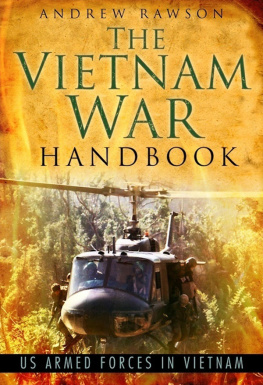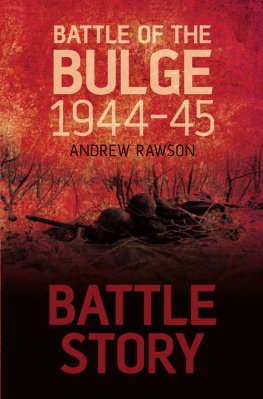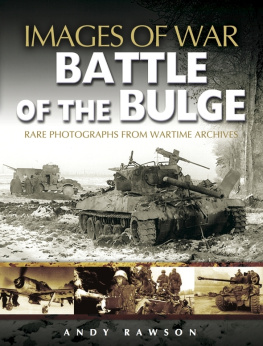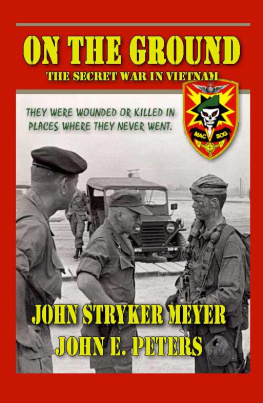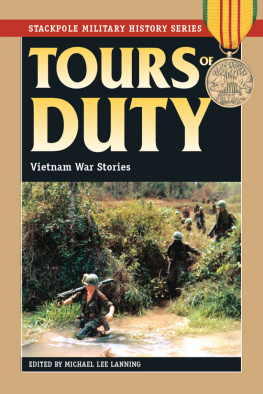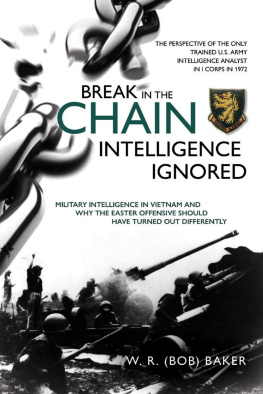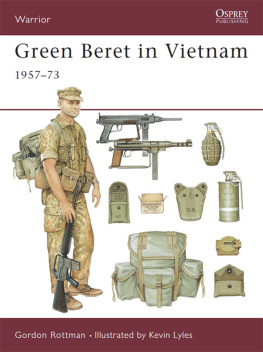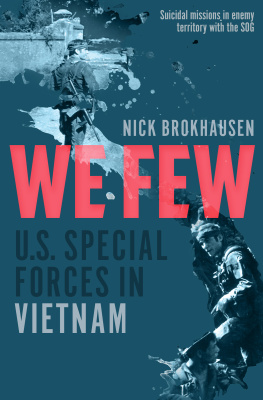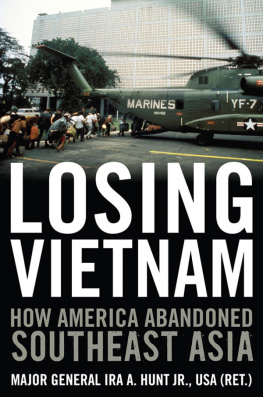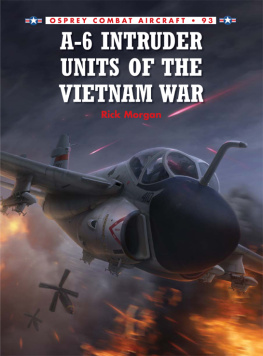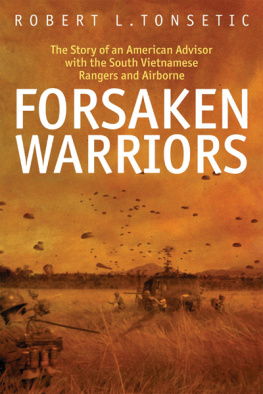Andrew Rawson - The Vietnam War Handbook: US Armed Forces in Vietnam
Here you can read online Andrew Rawson - The Vietnam War Handbook: US Armed Forces in Vietnam full text of the book (entire story) in english for free. Download pdf and epub, get meaning, cover and reviews about this ebook. City: Cheltenham, year: 2016, publisher: The History Press, genre: History. Description of the work, (preface) as well as reviews are available. Best literature library LitArk.com created for fans of good reading and offers a wide selection of genres:
Romance novel
Science fiction
Adventure
Detective
Science
History
Home and family
Prose
Art
Politics
Computer
Non-fiction
Religion
Business
Children
Humor
Choose a favorite category and find really read worthwhile books. Enjoy immersion in the world of imagination, feel the emotions of the characters or learn something new for yourself, make an fascinating discovery.
- Book:The Vietnam War Handbook: US Armed Forces in Vietnam
- Author:
- Publisher:The History Press
- Genre:
- Year:2016
- City:Cheltenham
- Rating:5 / 5
- Favourites:Add to favourites
- Your mark:
- 100
- 1
- 2
- 3
- 4
- 5
The Vietnam War Handbook: US Armed Forces in Vietnam: summary, description and annotation
We offer to read an annotation, description, summary or preface (depends on what the author of the book "The Vietnam War Handbook: US Armed Forces in Vietnam" wrote himself). If you haven't found the necessary information about the book — write in the comments, we will try to find it.
The Vietnam War Handbook: US Armed Forces in Vietnam — read online for free the complete book (whole text) full work
Below is the text of the book, divided by pages. System saving the place of the last page read, allows you to conveniently read the book "The Vietnam War Handbook: US Armed Forces in Vietnam" online for free, without having to search again every time where you left off. Put a bookmark, and you can go to the page where you finished reading at any time.
Font size:
Interval:
Bookmark:
ANDREW RAWSON
THE
VIETNAM
WAR
HANDBOOK
US ARMED FORCES IN VIETNAM

First published in the United Kingdom in 2008
The History Press
The Mill, Brimscombe Port
Stroud, Gloucestershire, GL5 2QG
www.thehistorypress.co.uk
This ebook edition first published in 2016
All rights reserved
Copyright Andrew Rawson, 2008
The right of Andrew Rawson to be identified as the Author of this work has been asserted in accordance with the Copyrights, Designs and Patents Act 1988.
This ebook is copyright material and must not be copied, reproduced, transferred, distributed, leased, licensed or publicly performed or used in any way except as specifically permitted in writing by the publishers, as allowed under the terms and conditions under which it was purchased or as strictly permitted by applicable copyright law. Any unauthorised distribution or use of this text may be a direct infringement of the authors and publishers rights, and those responsible may be liable in law accordingly
EPUB ISBN 978-0-7509-7983-2
eBook converted by Geethik Technologies
All photographs, unless otherwise noted, are from the National Archives and Records Administration Photograph Collection, College Park, Maryland, USA. They are from the US Army Signal Corps, US Marine Corps, US Air Force and US Navy collections. Credits refer to the relevant photograph collection and image number.
The United States first contact with Ho Chi Minh, North Vietnams future leader, came during the Second World War. Minhs resistance fighters were engaged with the Japanese forces occupying French Indochina and as part of their struggle they gathered intelligence and rescued downed American pilots. At the cessation of hostilities US Army officers looked on while Ho Chi Minh rejected French rule of Indochina and declared Vietnams independence.
Americas support for Vietnam changed course in August 1950 when a small team of personnel arrived in Saigon to set up Military Assistance Advisory Group, Indochina, ready to distribute military aid delivered to Southeast Asia. Four months later equipment and supplies started to arrive, allowing the Vietnamese Army to expand in its growing fight alongside the French against the Viet Minh, Ho Chi Minhs Communists.
For the next three years the French engaged Minhs troops and they struggled to come to terms with a different kind of warfare, guerilla warfare. In November 1953 General Navarre decided to draw them into open battle, deploying a large concentration of troops at Dien Bien Phu near the Laos border. The Viet Minh soldiers took up the challenge, occupying the hills surrounding the French positions, and slowly tightened their stranglehold. Heavy fighting and dwindling supplies took their toll on the French and after six months they were forced to surrender on 7 May 1954. Two months later hostilities came to an end as Vietnam was split into two at the 17th Parallel.
The communists controlled the north while the French handed over the south to a new democratic regime led by President Ngo Dinh Diem. However, the Viet Minh continued the struggle in the south and it soon became clear that the South Vietnamese Armed Forces needed assistance to protect their borders and maintain internal security. The first group of US military advisors reached South Vietnam in March 1955 and eight months later Military Assistance Advisory Group, Vietnam, was organized to supervise a range of training programs to help the South Vietnamese.
The United States kept a close eye on developments in Southeast Asia, concerned by the worldwide spread of Communism (America was also extremely sensitive to home-grown Communism at this time) and it believed that if one country fell under its control, the rest of the area would follow; a theory branded the Domino Effect. Four years passed before events descended into a deepening circle of violence following North Vietnams announcement that it was changing its strategy from a political struggle to an armed struggle. President Dwight Eisenhower made the United States first public commitment to support South Vietnams fight for independence in April 1959 but it had little effect on Ho Chi Minhs followers and three months later two American servicemen were killed during an attack by Vietnamese Communists (now known as the Viet Cong).
North Vietnam began to step up the pressure in April 1960, in the hope of toppling the South Vietnamese government, and it began sending trained soldiers to the south to organize attacks while military conscription was introduced in the north. At the end of the year it announced that a new organization, the National Liberation Front, had been formed to lead the struggle in the south.
The beginning of 1961 saw John F. Kennedy elected as President of the United States and he continued Eisenhowers support, pledging further military assistance at the end of the year in response to a call for help from the South Vietnamese president. A new organization, Military Assistance Command, Vietnam, was formed in February 1962 to control the increase of American advisors and support personnel supervising the build-up of US war material.
The worlds attention was briefly centered on Cuba the following October as America confronted the Soviets over the deployment of missiles close to its shores, a confrontation which ended in a desperate nuclear standoff between Presidents Kennedy and Khrushchev. However, trouble was never far away in South Vietnam and on 1 November 1963 President Diems unpopular government was toppled by a military coup; the President was killed by his own soldiers.
Three weeks later, President Kennedy was assassinated on 22 November in Dallas, Texas, leaving Lyndon B. Johnson to take control of the uncertain situation in the United States and the countries it supported. He did not have to wait long before his resolve was tested.
North Vietnam began sending regular troops into South Vietnam in April 1964 to take advantage of the chaos left by the coup. An attack against a US base at Nam Dong on 6 July showed that the Viet Cong was determined to seize control whatever the cost and a month later they made a second hostile move against US military personnel.
US Navy ships had been patrolling off the coast of North Vietnam, monitoring vessel movements and coastal defenses since February 1964 and at the end of July they were given permission to shell targets in the Gulf of Tonkin. On 2 August, North Vietnamese patrol boats attacked the destroyer, USS Maddox and while F-8 Crusader fighter planes from USS Ticonderoga sank one of the boats, it marked the first time that North Vietnamese and American servicemen had openly engaged each other (undercover operations involving Special Forces teams had been underway for some time). A second destroyer, USS Turner Joy, joined Maddox later that evening and patrolling resumed but two days later the North Vietnamese allegedly made a second attack (several key witnesses later reported that the second attack never took place).
President Johnson acted immediately on the information available, ordering retalitory airstrikes against North Vietnamese naval bases and a fuel depot. He also presented the Tonkin Gulf Resolution and on 7 August, the United States Congress and Senate passed it, authorizing the President to deploy US Armed Forces to defend the non-Communist nations of Southeast Asia.
Johnson was elected President on 3 November, and two months later he was called upon to use his Resolution when the Viet Cong attacked US military installations in Pleiku. US Navy planes based on carriers stationed in the South China Sea responded by attacking targets across North Vietnam. With the threat of attacks against military installations mounting, Johnson increased the stakes, ordering the deployment of ground troops to protect them. 9th Marine Expeditionary Brigade landed at Da Nang on 8 March where the bemused Marines were greeted by government officials and cheering civilians carrying garlands of flowers. In May 173rd Airborne Brigade, the first US Army unit to deploy, arrived at Bien Hoa to the north of Saigon. It was the start of an eight year commitment of US ground troops to South Vietnam, one that would cost thousands of lives, force many more to leave their homes and change the lives of everyone who was involved.
Next pageFont size:
Interval:
Bookmark:
Similar books «The Vietnam War Handbook: US Armed Forces in Vietnam»
Look at similar books to The Vietnam War Handbook: US Armed Forces in Vietnam. We have selected literature similar in name and meaning in the hope of providing readers with more options to find new, interesting, not yet read works.
Discussion, reviews of the book The Vietnam War Handbook: US Armed Forces in Vietnam and just readers' own opinions. Leave your comments, write what you think about the work, its meaning or the main characters. Specify what exactly you liked and what you didn't like, and why you think so.

